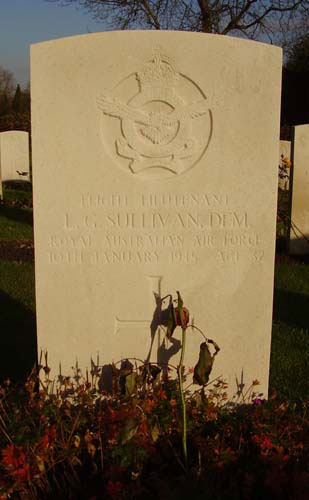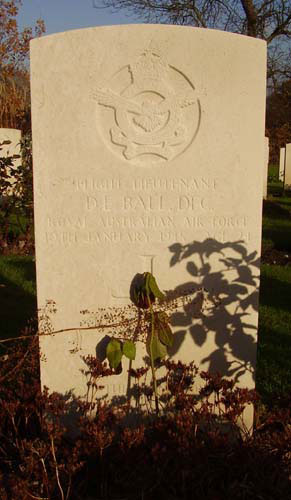Mosquito NS891 near Wharram Percy.
On 10th January 1945 the crew of this aircraft were undertaking a low level cross-country navigation flight in poor weather. After flying into a snowstorm and during a low-level part to the flight with visibility down to fifty yards the aircraft struck a tree on the edge of the Yorkshire Wolds at 10.45hrs. The crash occurred in the region of Wharram Percy Farm and Toisland Farm near the deserted village of Wharram Percy and overlooking Birdsall village. Both men were buried at Harrogate on 15th January 1945 and both are believed to have been qualified pilots. The aircraft was part of No.2 Group Support Unit. In 1944 / 1945 No.2 Group Support Unit was set up to supply operational units in No.2 Group with personnel as they took losses.
Mosquito NS891 was delivered to the RAF in April 1944 and served with 464 Squadron until transfer to December 1944. Following the accident detailed above Cat.E2/FA Burnt damage was recorded on the aircraft and it was struck off charge. Of interest is that 464 Squadron were part of No.2 Group who undertook a number of low-level and precision bombing attacks in 1944 and 1945. Other units who 2 GSU supplied aircrew to also flew such low-level operations and it seems likely that the crew of this aircraft were undertaking a flight at very low level to practice such flying. One such target they would attack operationally was the Gestapo headquarters in Denmark. With 464 Squadron being an Australian squadron and the crew being of the same nationality this would also seem logical of a typical unit these men would have been posted to had they completed their training.
Pilot - F/Lt Laurence Gerard Sullivan DFM RAAF (409250), aged 32, of Macarthur, Victoria, Australia. Buried Harrogate Stonefall Cemetery, Yorkshire (H/E/3).
Pilot - F/Lt Dudley Edgar Ball DFC RAAF (420849), aged 24, of Lidcombe, New South Wales, Australia. Buried Harrogate Stonefall Cemetery, Yorkshire (H/E/4).
Laurence Sullivan was born on 27th September 1912 in Hamilton, Victoria. He enlisted there on the 20th July 1941 and after initial training awarded his Wings
on 29th April 1942. On arriving in the England he firstly trained with 15 (P)AFU beginning on 26th January 1943 after which he was posted to 21 OTU on 16th March 1943
and then a posting to 150 Squadron in North Africa in June 1943. He was commissioned to P/O on 1st August 1943. He was awarded the DFM on 6th December 1943 for work
carried out before he was commissioned with 150 Squadron, the citation reads.. "As an NCO P/O Sullivan took part in a large number of attacks against the enemy in Tunisia, Sicily and Italy, the majority of which have been against well defended targets. The excellent photographs he has obtained well demonstrate the courage and determination he has exercised in pressing home his attacks. P/O Sullivan has also flown in direct support of our landing troops during the invasion of Sicily, bombing with great precision. Throughout, he has shown a high degree of skill and devotion to duty." From October 1943 he did not fly operationally, he was posted to 76 OTU in November 1943 (at Aqir, North Africa) and at this date he is listed as having over 1000 flying hours to his name. Here he took an instructional role and on leaving in September 1944 his CO gave him a good report, stating that he was "a very zealous officer who displayed an above average initiative and drive and a high sense of responsibilty". He had risen to F/O on 2nd February 1944 and took the rank of Acting F/Lt on 1st July 1944. After leaving Aqir he was posted back to England and arrived at 2 Group Support Unit (2 GSU) on 28th November 1944 to train to fly low-level Mosquito operations to attack important German targets. He was initially posted to Swanton Morley, and later the unit moved to Fersfield from where NS891 is believed to have been based. His DFC was not presented to him before his death, on 30th November 1945 his father John Sullivan collected it from Government House, Melbourne, Australia.
Dudley Ball was born in Upminster, Essex, England on 17th May 1920 but his family moved to Australia when he was young. He enlisted in Sydney on 6th December 1941
and after initial training left Australia on 2nd November 1942 and trained as a pilot. Not much is currently known about his career prior to being posted to 2 GSU other
than he was awarded the DFC (possibly on 18th August 1944 for service on Lancasters with 625 Squadron). The photograph of him above (out of copyright and found on the Australian War Memorial website). The same Australian War Memorial website give differing details for his DFC, stating it was awarded posthumously on 12th July 1945 for his "skill and fortitude in operations against the enemy. His rank on his grave is F/Lt, although Australian records suggest he took the rank of Acting F/Lt on 16th June 1944 and relinquished this rank on 17th November 1944, probably after posting to 2 GSU and reverted to F/O. Other websites record him as serving with "2 Gunnery Research RAF" at his death which I believe to be an error.
Also of note is that Fersfield airfield was also the based used around the same time for a secret drone USAAF B17 project. One such drone crashed
soon after taking off and killed the brother of future US president John F Kennedy.



No.2 Group was part of Bomber Command for the first half of the War, in May 1943 they left and joined the new 2nd Tactical Air Force, under Fighter Command control and then became part of the Allied Expeditionary Air Force by the end of 1943. They took part in Operation Market Garden in September 1944. Today No.2 Group still exists and encompasses a number of roles, including air-to-air refueling and the Sea King ASR units.